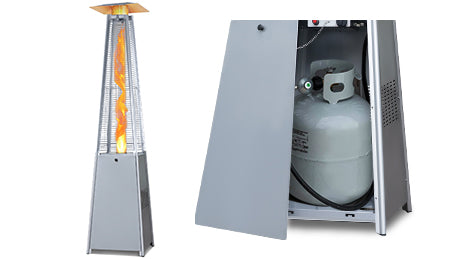Your patio is a terrific area to host friends during the summer, and it can be challenging to give it up as the weather cools. With a patio heater, you can stay warm while spending more time outside. When it comes to patio heaters, you have a variety of alternatives. Look over these possibilities and choose the one that best suits your outside environment. Continue reading to learn about the size of the propane tank?
Patio heaters come in a variety of types and sizes. Aside from aesthetics, each variety has its own set of pros. As a result, it's critical to choose functionality over aesthetics while making a purchase.
There are no one-size-fits-all propane tanks. Whether you're using propane for house or business, there are many options available—and that's only the beginning!
When determining what size of the propane tank is best for your needs, there are various elements to consider. Lausiant is the company to call—we have years of experience and knowledge to help you determine the right propane tank size.
Here's an overview of the size of the propane tank available and required to meet your home or company.
Tanks weighing 20 to 100 Pounds
Unlike the larger tanks set to one location, these are portable tanks or cylinders. The most prevalent uses are grills, outdoor propane equipment such as firepits, camp stoves, decks, patio heaters, and portable generators. They may also be used to heat, cook, and heat water in RVs and provide electricity for refrigerators. They can operate commercial mowers, temporary heating equipment, forklifts, and other equipment.
Tanks with 60 Gallons Capacity
Small propane appliances, such as a space heater, require a tank of this size. However, it isn't big enough for commonly used appliances like a stove or a water heater.
Tanks 120 Gallons Capacity
Do you cook with propane, heat your water, dry your clothes, or light a fire with it? A tank of at least this size is required. However, it cannot be used to heat the entire house.
Tanks 250 Gallons Capacity
You'll need at least this size of the propane tank if you have three or more gas appliances. It may be sufficient for whole-house heating if you have a tiny, single-story home.
Tanks with 320 to 500 Gallons Capacity
Propane is an environmentally safe, energy-efficient, and cost-effective way to heat your home. These tanks are designed to heat an entire house.
Tanks with 1,000 Gallons Capacity
Commercial applications for these tanks include anything from interior heating to fleet fuelling and cooking in restaurants and commercial kitchens. This size of the propane tank may be the ideal option if you have a large home and use propane for heating, cooking, water heating, and other auxiliary items like pool and spa heating.
Hanging heaters to full-size free-standing units are available in a wide range of sizes. Most portable heaters have a propane tank that fits neatly into the base.
Advantages of 20 Pound Propane Tank
- The setup is simple.
- Maintenance-free
- Portable and permanent styles are available.
- Safety Features are included.
Performance and Requirement
Propane patio heaters are a versatile and practical option to heat your outside space because it is a mobile fuel that doesn't require additional plumbing or installation.
Propane gas is non-toxic and will not harm the environment or water. It's possible to have it professionally installed for long-term use.
Patio Heaters produce the same amount of heat in a short amount of time as natural gas heaters and can be made permanent with a gas line installation by a qualified technician.
BTU & Size of the Propane Tank
British Thermal Units, or BTUs, quantify the power of a gas patio heater. The amount of heat produced by a gas appliance is measured in BTUs.
Propane has a BTU density of 2,500 per standard cubic foot, making it a very efficient fuel.
When compared to natural gas and electric patio heaters, propane patio heaters are the most expensive to operate.
The price of propane gas is expressed in dollars per gallon. A 20lb propane tank, or around 4.7 gallons of fuel, is typical of a portable propane patio heater.
Safety
Always study the owner's manual before installing propane patio heaters to verify the necessary clearance to combustibles (items that catch fire) and the right location for the heaters.
Always keep these distances in mind, and only use gas patio heaters in an open area with lots of ventilation.
Look for patio heaters that are certified for the safest solutions. These certifications guarantee that each heater has undergone extensive testing to ensure reliable and secure heating equipment.
Before using your propane patio heater, please read the installation manual to know how to set it up and use it correctly.
You'll need to do the following:
- Examine the heater for any signs of wear and tear.
- Examine the propane tank for any signs of damage.
- Make that all gas connections, lines, fittings, and hoses are in good operating order.
- Always switch off the control knob, disconnect the propane tank, and place your patio heater upright in a covered area away from the elements when you're finished using it.
When handling a propane tank, be careful not to damage the valves. Follow the manufacturer's instructions when filling, transporting, installing, and utilizing a propane tank.
Before each use, examine all connections and hoses. Never put too much propane in a propane tank.
Propane tanks should be kept upright when not in use. Please keep them in a cold, dark, and well-ventilated area outside.
Keep patio heaters out of the reach of children and never leave them unattended.
Spare propane tanks should be maintained at least 20 feet away from active patio heaters. It will prevent a fire or explosion if the extra tanks touch the patio heater's extreme heat.
Because the molecules in propane slow down when the temperature drops, the pressure in your propane tank may reduce as the weather cools.
To keep your propane tank performing at its best, ensure it has a pressure regulator, keep it whole, and store it away from snow and ice.
Because propane gas is odorless, it is given a particular odor to help you detect its existence. The smell is pungent and nasty, resembling rotten eggs.
You may have a gas leak if you smell propane gas. When detecting and correcting a leak, always consult the owner's manual.
If you suspect a gas leak but don't smell it, turn off your patio heater and take the following precautions:
- Mix equal quantities of liquid soap and water to make a soap solution.
- Using a spray bottle, towel, or brush, apply soapy water to the gas connections.
- There is a leak if you see bubbles.
- Turn off the gas and fix any loose fittings.
- Step 2 should be repeated.
If you can't discover the source of the leak but still smell gas:
Please turn off the gas and unhook the heater from it. Lights, appliances, and cell phones should all be turned off (anything that can spark). Call your propane provider, the local fire department, or 911 to get out of the area.
Before using any propane-fueled appliances, a skilled service professional must ensure that your propane system is leak-free. If you discover the source of the leak, make sure the gas is turned off and the heater is disconnected before attempting to repair it.
When testing, repairing or maintaining the heater, always follow the manufacturer's instructions. A licensed specialist must repair your heaters. Accomplish, not try to do it on your own.
Gas lines, hoses, fittings, and connectors may need to be replaced to fix the leak. The patio heater will be ready to use once all leaks have been repaired.
In short, Propane Tanks range in size from compact 20-pound containers to over 2,000-gallon tanks. The size of the propane tank is determined by the size of the home and the size of gas-powered appliances.
Your geographic location and local environment may influence the size of the propane tank. A tank for heating in a milder region, for example, may not need to be as large as one for heating in a colder area. This guide will assist you in determining the correct size propane tank for your needs and space.
Conclusion
Propane patio heaters are simple to set up and operate. They swiftly heat up and will have your patio toasty warm in minutes. They don't need to be installed by a professional, and they run on the same tanks as your gas barbecue.
A 20 lb propane tank will last approximately 10 hours. Replacing the tank is as simple as going to any retailer that exchanges propane tanks. We hope you will get the answer for what should be the size of the propane tank for the patio heater, natural gas patio heaters, and table top patio heater.






